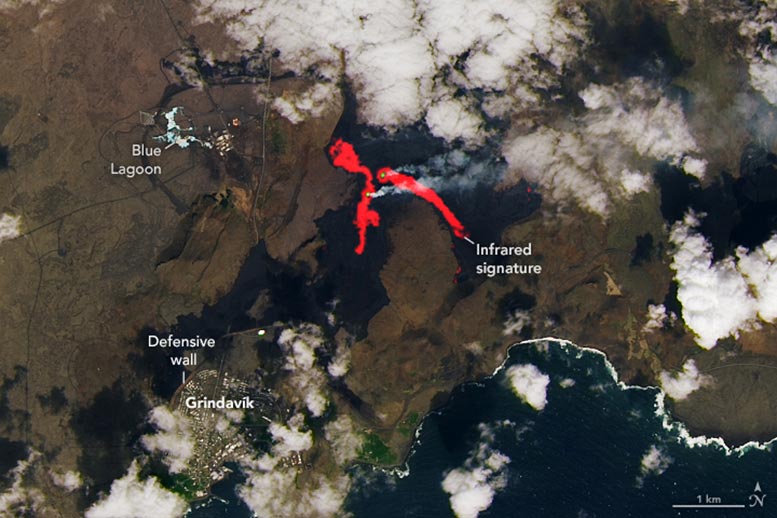A volcanic fissure on Iceland’s Reykjanes peninsula erupted in late May 2024, marking the continuation of a series that began in December 2023. The area experienced significant magma accumulation since the previous eruption in March, and the renewed lava flow impacted local infrastructure and prompted evacuations, including at the Blue Lagoon geothermal spa. (Photo of a previous volcanic eruption in Iceland.)
A volcanic fissure on Iceland’s Reykjanes peninsula came alive again with voluminous, vigorous flows.
Iceland’s Reykjanes peninsula experienced a volcanic eruption in late May 2024, with satellite images from early June showing subsided activity. The eruption followed significant magma buildup and affected nearby communities and infrastructure.

Satellite image of the ongoing eruption on Iceland’s Reykjanes peninsula captured on June 2, 2024, by the Operational Land Imager on Landsat 8.
Recent Volcanic Activity on Reykjanes Peninsula
In late May 2024, a volcanic fissure on Iceland’s Reykjanes peninsula reawakened. This eruption, the latest in a series that began in December 2023, was notable for its vigorous start. Some of the highest estimated lava flow rates of all the recent eruptions near Grindavík occurred in the first hours of the eruption.
The Landsat 8 satellite’s Operational Land Imager (OLI ) captured this image of the ongoing eruption on June 2, 2024. The natural-color scene is overlaid with an infrared signal to help distinguish the lava’s heat signature. By this time, volcanic activity along a fissure extending up to 3.4 kilometers (2.1 miles) long had subsided after its initial burst. The most active areas, emitting the hottest thermal signals (light green), are near one of the craters that erupted in March 2024, according to the Icelandic Met Office (IMO). Much of the black area in the image is cooled lava, but note that dark shadows from clouds are also present.
Magma Accumulation and Eruption Dynamics
Models indicated that 18 million cubic meters of magma had accumulated beneath the fissure since the March eruption, the IMO reported. This was the largest volume of magma to build up in the reservoir since the intrusion first formed in autumn 2023. And the lull in aboveground activity between March and May represented the longest period since late 2023 that magma had accumulated without erupting.
Impact on Local Areas and Air Quality
When lava did break through to the surface at 12:46 p.m. local time on May 29, it gushed at an estimated 1,500 cubic meters per second for several hours. For comparison, lava discharged at an estimated 1,100-1,200 cubic meters per second in the early hours of the March eruption and 600 cubic meters per second at the start of the February eruption.
The flows again covered roads and threatened the town of Grindavík, which has largely remained empty since evacuations in late 2023. Human-built defensive walls along the northwest side of town diverted lava away from buildings. Flows also spurred renewed evacuations at the Blue Lagoon, a geothermal spa several kilometers north of Grindavík. When it reopened on June 2, visitors could see molten lava erupting in the distance.
As with previous bursts of activity, this eruption did not disrupt air travel; effusive eruptions such as these tend to emit minimal ash. However, the long daylight hours increased the likelihood for volcanic smog, or vog, to form, and this haze was observed in different parts of the country, the IMO reported. Vog, which consists primarily of very fine sulfate (SO4) particles, forms when sulfur dioxide and other volcanic pollutants mix with oxygen and water vapor in the presence of sunlight.




















Discussion about this post